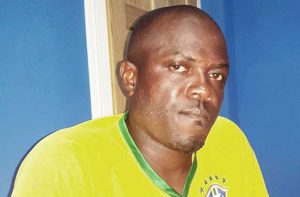IT was an emotional scene on Wednesday at the Georgetown Magistrate’s Court when Regan Rodrigues, known as ‘Grey Boy’ dropped on his knees and wept bitterly after hearing that the office of the Director of Public Prosecutions (DPP) wanted him to face a judge and jury for the murder of political activist, Courtney Crum-Ewing.
Rodrigues continued to maintain his innocence before Magistrate Judy Latchman and Special Prosecutor, Nigel Hughes and even threatened to kill himself as he vented his frustration after being tried for the murder twice and acquitted both times.

After a tense delay of 10 minutes, Magistrate Latchman upheld the decision she made at the end of the Preliminary Inquiry (PI) on Monday when she discharged the case against Rodrigues for the second time.
With the news of his freedom, Rodrigues, who has been in police custody since April 14, 2017, collapsed and wept with a Bible in his hands, as his mother rushed and embraced him. He was then taken to the Brickdam Police Station to sign the documents for his release.
DPP INSTRUCTS MAGISTRATE
Even though the case against Rodrigues was dismissed on Monday, the police had kept Rodrigues in custody since the office of the Director of Public Prosecutions (DPP) had instructed Magistrate Judy Latchman, via a letter, to commit Rodrigues to stand trial in the High Court.
The matter was recalled on Wednesday in the presence of the Special Prosecutor; the courtroom was filled to capacity with relatives and spectators as the Magistrate addressed the directive issued by the DPP, Shalimar Ali-Hack.
Magistrate Latchman maintained that a prima facie case was not made out against Rodrigues, in relation to the murder. On Tuesday, the DPP wrote a letter to the Magistrate, instructing her to commit the matter to the High Court for trial.
“In accordance with section 72 (2) (ii) (a) of the Criminal Law (Procedure) Act, Chapter 10:01, I hereby remit to your Worship the above-mentioned matter and direct you to comply with Sections 65 and 66 of the Criminal Law (Procedure) Act, Chapter 10:01 with a view of committing the accused,” the letter said.
BROKE DOWN IN TEARS
After hearing the contents of the letter, Rodrigues broke down in tears and dropped to his knees while in the prisoners’ dock.
“They want see me convicted for this murder na?” Rodrigues said to the Magistrate.
Without waiting for the Magistrate to reply, the 40-year-old attempted to walk out of the prisoners’ dock and shouted: “ I can’t take this thing no more… how much time I must be freed from this charge to prove to them that I’m innocent?”
He then turned to the relatives of Crum-Ewing and said: “Is best I kill myself and let these people feel nice.”

The Magistrate took into consideration what was said by Rodrigues while there was no response from Hughes. The matter was adjourned for less than 10 minutes while persons sat at the edge of their seats awaiting the outcome in the courtroom. When the Magistrate emerged from the Chambers, she upheld her initial ruling, despite the objection raised by the DPP.
“There is absolutely no evidence,” the Magistrate noted as she dismissed the charge again and told Rodrigues that he was free to go.
On Monday, Magistrate Latchman dismissed the case on the grounds that there is insufficient evidence against him. In her ruling, the Magistrate said that while she was satisfied that the gun, which was used to shoot Crum-Ewing, was found at the home of the accused, the evidence offered by the prosecution did not implicate Rodrigues in the actual murder.
In relation to the 14 oral statements made by Rodrigues, which were admitted into evidence, the Magistrate said they did not implicate him in the murder and there is no evidence that Rodrigues used the gun, pulled the trigger and shot Crum-Ewing.
But in an interview with the Guyana Chronicle on Tuesday, the special prosecutor said that in one of Rodrigues’s oral statements, there is sufficient evidence that he has knowledge of the murder.
According to Hughes, when Rodrigues was first arrested by the police at his home in River View, Ruimveldt, he had said to the ranks: “Officer, yuh can’t arrest me with this gun, this gun used to do nuff thing.”
As such, Hughes emphasised that based on this statement by Rodrigues, it shows that the accused had knowledge of the crime and what the gun was used to do. Additionally, Hughes, who is a prominent attorney, told this newspaper the fact that the murder weapon was found in the home of the accused, shows that there is sufficient evidence for the matter to be committed to the High Court
In September 2016, Rodrigues was freed of the murder charge by Magistrate Latchman, due to the lack of evidence. The office of the DPP decided to re-open the case for further evidence from police witnesses and for the magistrate to rule on the oral statements made by Rodrigues.
The bullet-riddled body of Crum-Ewing was found at Third Avenue, Diamond New Scheme, EBD, on March 10, 2015. The 40-year-old was shot twice to the temple, once to the back of the head and twice to the stomach.
The police in a statement had stated that the political activist was accosted by four men in a car, one of whom discharged several rounds, hitting him about the body. It was reported that the killer (s) used a .32 pistol to execute Crum-Ewing.
The political activist was well known for his one-man protest outside the office of former Attorney General (AG) Anil Nandlall. Minutes before he was gunned down, he was reportedly heard via a bullhorn urging residents of the neighbourhood to vote against the then ruling PPP/C party.



.jpg)








